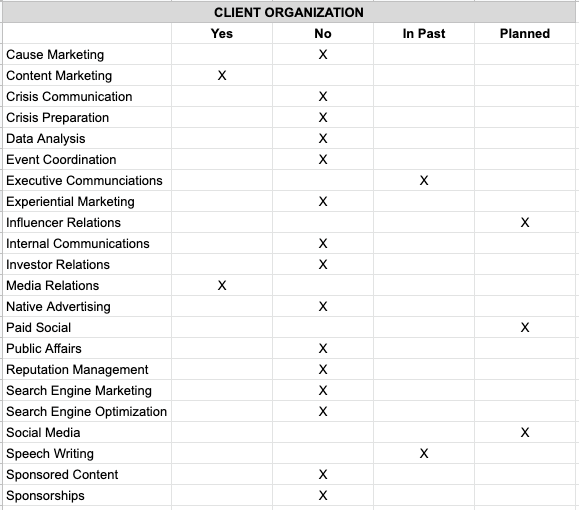 We talk to lots and lots and LOTS of agency owners every month about the state of their businesses, the state of the industry, and the challenges that come with building and scaling a service-based business.
We talk to lots and lots and LOTS of agency owners every month about the state of their businesses, the state of the industry, and the challenges that come with building and scaling a service-based business.
There is one thing we find everyone has in common in 2019: clients are consistently hiring out projects, but retainers seem to be few and far between.
It’s great, of course, that clients are still outsourcing their marketing and communications needs, but it’s terribly difficult to run an agency when you don’t have consistent cash flow.
Betsy Cooper likes to tease me about this (mostly because she’s the same way!).
She always says, “It’s because you can’t control when the cash comes in that drives you crazy.”
Well. Yes.
It SHOULD drive me crazy—and you crazy—and all of us crazy.
You can’t make strategic decisions, such as hiring or, heck, even new technology or software, if you can’t predict your cash flow for the year…or even quarter.
A girlfriend and I were commiserating about this a few weeks ago—and talking about all the different ways you can get a client to agree to a retainer (or, what I like to call, consistent and predictable cash flow) without a retainer.
Here are some of the ideas we threw out there.
Multiple Projects By Budget
Some clients don’t like the sound of a retainer. They think it locks them into something that multiple projects does not.
(Whether or not that’s true is another story for another time.)
But they’re more than happy to keep working with you, year-over-year, assuming you continue to provide great work.
Find out what their budget is for the year—and ask them how they’d like to use it.
What we’re finding right now is clients may have a budget of $120,000, but don’t want to give an agency a monthly retainer of $10,000.
Instead, propose six $20,000 projects throughout the year.
Typically, a client with a set budget and a list of priorities will be very happy to sign your contract and work with you this way.
Just make sure you have the proper termination clauses, just like you would with a retainer client.
Break Comms Plan Into Quarterly Projects
No one wants to craft a communications plan and then execute only a quarter or two of it.
But what if you could show how the projects can stand alone—and work together?
For example, let’s say the goal of the communications department is to increase sales qualified leads by 15%.
You can’t do that with one project, nor can you do it in only three months.
But you can break it into smaller chunks:
- Project #1: increase domain authority and search rankings on two priority keywords/phrases
- Project #2: increase email subscribers and downloadable content
- Project #3: increase marketing to qualified leads by 30%
- Project #4: increase sales qualified leads by 15%
Each of these projects on their own are valuable and worth the investment, and they’re more powerful when woven together.
Ingrain Yourself Into Their Business
Back when I worked for the big agency (and I did this a bit when I started my own), my favorite thing to do was work on-site for clients.
Not only did I get more access to the executives, I learned far more just by sitting there in a cubicle than I would have by having a weekly phone call update.
So you got a project? Great!
Tell the client you’d like to show up at their offices once a week to work collaboratively on the project.
You can sit in a cube and not bother anyone.
And this gives you an opportunity to eavesdrop or attend strategic meetings.
During your time there, you’ll uncover more projects and more needs—and, because you’re right there when they’re discussing them, can offer your agency to execute the work.
Keep Your Services Top-of-Mind
Create a graphic of all of the services you offer and then “check off” which ones the client is using.

Include this graphic with every invoice, and use it as a way to showcase the work you do, the work you have planned, and the work you can do, if there is a need.
At the very least, it keeps your services top-of-mind so when clients are discussing the need for something you can deliver, you’re the first agency they think of.
The last thing you want to have happen is for the client to tell you they’ve an agency to do internal communications—and they never talked to you about it.
(Not, you know, that that’s ever happened to me.)
Keep your services top-of-mind.
Just because you’re working with them on one project, doesn’t mean they’re even thinking about other things you can do with them.
Build a Strategy Session “Product”
This is how we approach every, single client engagement—they have to go through our two-day, in-person strategy session.
It has a few different costs (if we have to travel, if I’m in the room, how many people from my team are required), and they pay upfront before we schedule the session.
Then we work with them, rather intensely, for two full days to develop their marketing communications plan.
This does a few things:
- Allows us to get deeply ingrained in their business quickly.
- Gives us immediate access to the executive team—and helps us build relationships fast.
- Allows us to “date” before we jump into a long-term relationship.
- Provides us the opportunity to give them a deliverable at the end of the session versus 60 days after they hire us.
- Creates a conversation about priorities, who can do what, and determine a realistic budget.
- Stop giving away ideas for free in a proposal that may or may not ever come to fruition.
But the biggest benefit?
The client always, always, always spends more money with us than they would have had we proposed a full year communications program.
Grow Your Agency Without Retainer Work
It stinks that we’re in an environment that clients only want to do project work.
And that’s always a leading indicator of a forthcoming down economy.
But if you’re prepared and are willing to dissect your typical annual retainer a bit differently, you’ll be able to predict cash flow, meet your growth goals, and perhaps make even more money than you anticipated.
What are some things that have worked for you if a client doesn’t want to sign a retainer agreement?
The floor is yours.
Image by Harry Strauss from Pixabay